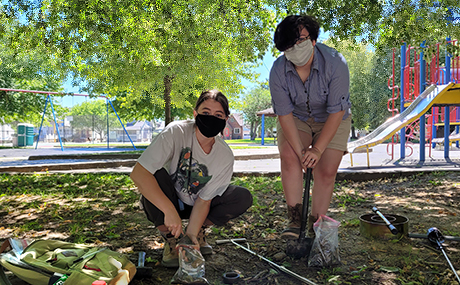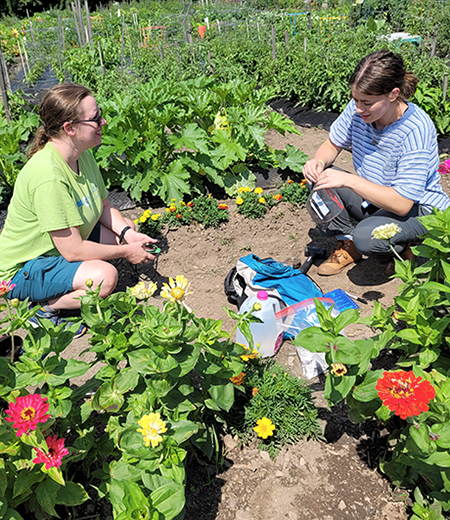 Their
work
starts
at
the
ground
level,
literally
…
as
they
traverse
through
vacant
lots,
community
gardens,
playgrounds
and
homeowner
yards
with
hefty
backpacks
filled
with
trowels,
plastic
bags,
meters
and
other
equipment.
They've
logged
in
hundreds
of
miles
on
their
cars
and
gathered
soil
samples
from
east
to
west
across
Greater
Cleveland.
Their
work
starts
at
the
ground
level,
literally
…
as
they
traverse
through
vacant
lots,
community
gardens,
playgrounds
and
homeowner
yards
with
hefty
backpacks
filled
with
trowels,
plastic
bags,
meters
and
other
equipment.
They've
logged
in
hundreds
of
miles
on
their
cars
and
gathered
soil
samples
from
east
to
west
across
Greater
Cleveland.
Research is at the center of their project. But for BW students Rowan Rindfleisch Huntley '24 and Emmalee Keep '22, advocacy is the passion that makes the countless hours, travels and calculations they've done personally and professionally fulfilling. Together with research lead and BW environmental science assistant professor Dr. Annette Trierweiler, the two students are tackling the environmental justice issue of redlining and its effects on communities and individuals.
"Urban ecosystems and how they function and can become degraded is of interest to me," explained Trierweiler. "Our research aligns with a larger national effort to examine the impacts of redlining on urban soils.
"Redlining is a discriminatory housing practice from the past," noted Trierweiler. "It often resulted in a denial of services and lack of investments in neighborhoods of minority and immigrant communities. The documentation of these disparities has largely been social, economic and political, but rarely environmental."
 She
went
on
to
say
that
with
the
permission
of
home
and
property
owners,
they
collected
a
small
sample
of
soil
from
each
site.
The
soil
was
then
tested
and
analyzed
for
lead
and
other
carbon
and
chemical
properties.
Their
sampling
sites
included
Cleveland
neighborhoods
-
Cark-Fulton,
Collinwood,
Detroit-Shoreway,
Edgewater,
Lee-Miles
and
Kamm's
Corners
-
as
well
as
surrounding
suburbs
like
Berea,
Bedford,
Parma,
Shaker
Heights
and
Euclid.
She
went
on
to
say
that
with
the
permission
of
home
and
property
owners,
they
collected
a
small
sample
of
soil
from
each
site.
The
soil
was
then
tested
and
analyzed
for
lead
and
other
carbon
and
chemical
properties.
Their
sampling
sites
included
Cleveland
neighborhoods
-
Cark-Fulton,
Collinwood,
Detroit-Shoreway,
Edgewater,
Lee-Miles
and
Kamm's
Corners
-
as
well
as
surrounding
suburbs
like
Berea,
Bedford,
Parma,
Shaker
Heights
and
Euclid.
"In our study, we wanted to address several factors," said Trierweiler. "For example, kids are more prone to lead toxicity. Therefore, taking samples from playgrounds and other areas where children congregate was important for understanding potential contamination exposure. Likewise, community and homeowner gardens provided insight into food safety to assess if soil was safe for growing food or if fresh soil was needed to bring it to EPA (Environmental Protection Agency) levels of safety.
"Collecting and analyzing this data provides a lens through which we can measure how neighborhoods where there is historical documentation of redlining practices were affected. Beyond the research findings we uncover, there is a greater consideration of environmental justice and giving home and property owners advice to improve safety," she went on to say.
"Translating science into something that can have an important community impact is very important to students like Rowan and Emmalee, who want to make a difference in social justice and activism," emphasized Trierweiler.
For environmental science majors Keep and Rindfleisch Huntley, the project enabled them to delve into areas of interest within the scope of the research study. Keep wanted to investigate the correlation between food insecurity and soil health. Rindfleisch Huntley wanted to provide valuable information to community organizations about potential lead contamination.
"Although redlining was almost 100 years ago, what we are seeing now is that these communities, which were deemed unsafe to loans and investments, are still seeing countless negative effects of redlining," asserted Keep.
"My biggest goal in whatever I do as a career is to focus on the power of community and to amplify unheard voices. I can share my scientific knowledge, but what I ultimately want is for the people within their communities to have the power to change the injustices they face," emphasized Keep, who grew up in Medina, Ohio.
Rindfleisch Huntley shares a similar vision. The North Olmsted, Ohio, resident is excited to be working in an urban environment and providing resources at no cost to the organizations and homeowners.
"Lead in soil can be dangerous to children, animals and adults. It can also create food deserts or areas where growing crops is impossible or lead levels are above safe levels to eat. Our research is more than just data - it is about looking at cycles of poverty that were brought on by generations of people's inability to improve their living conditions and take safety measures such as removing lead paint," remarked Rindfleisch Huntley.
"It has been amazing to work so closely with the communities we are serving," continued Rindfleisch Huntley. "I love working with nonprofit organizations and hope to incorporate research and community outreach. My dream career would be to examine the consequences of environmental change in urban areas. But for now, I can't wait to see the impacts this study can have for the betterment of our neighborhoods and the individuals who call it home."